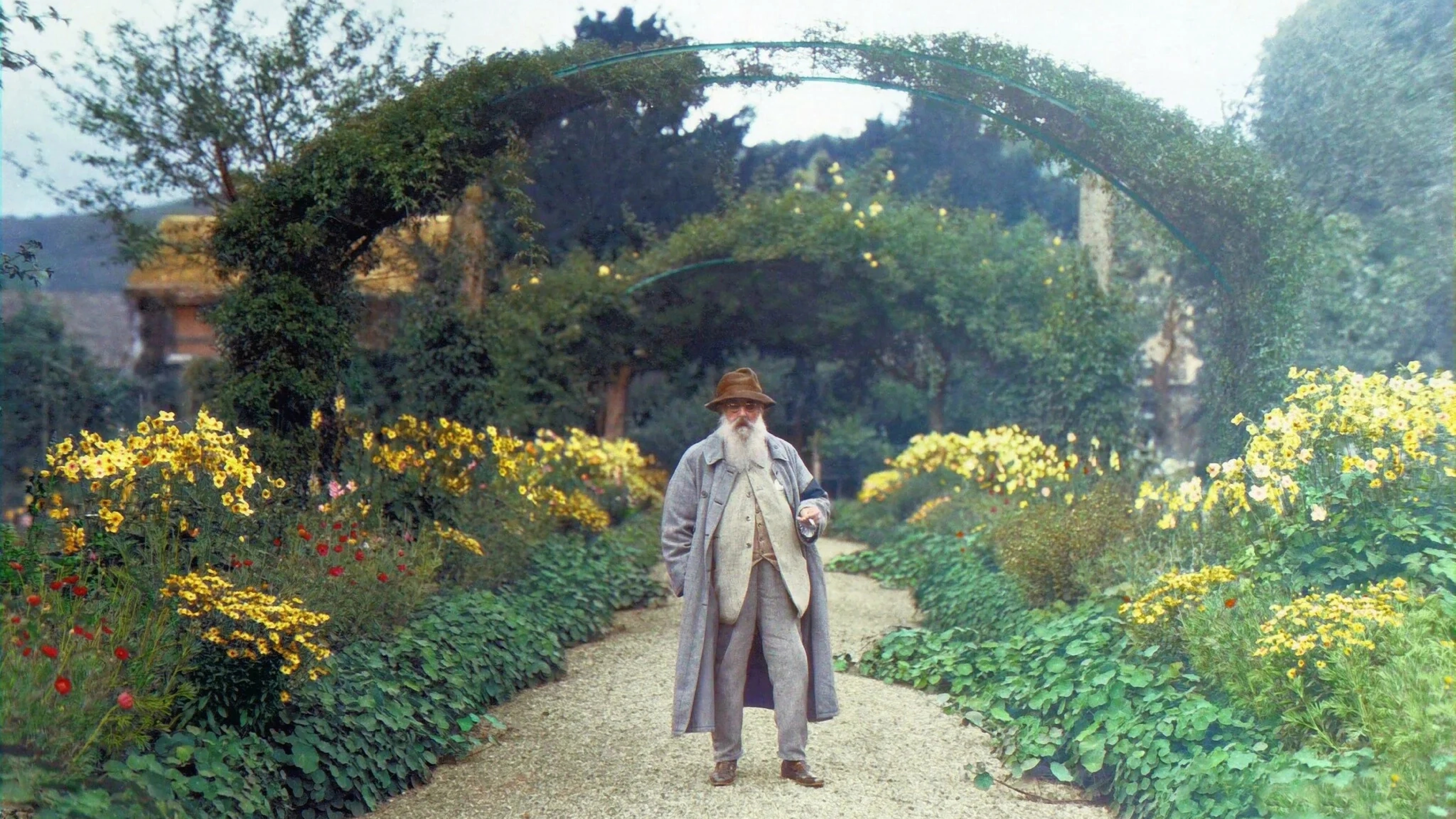Spaces is an exercise in curiosity about communal living and domestic activity. Each week we’ll select a Nation amenity and explore some of our other favourites from around the world, often drawn from fiction and throughout time.
Inspired by our recent In A Room feature with artist Kate Banazi, we're taking a look at a very special type of spaces, places where we come to rest, reconnect, and get inspired — gardens.
The history of gardens dates back to ancient civilizations, where they were cultivated for practical purposes like food production and medicinal herbs. Over time, gardens evolved into spaces of beauty, leisure, and spiritual significance. The Hanging Gardens of Babylon, one of the Seven Wonders of the Ancient World, exemplify early garden grandeur. In medieval Europe, monastery gardens provided medicinal herbs and food. The Renaissance brought ornamental gardens, symbolizing wealth and artistic expression. Today, gardens are cherished for their aesthetic appeal, recreational value, and mental health benefits, offering a serene escape from urban life and fostering a connection with nature.
Here are some of the gardens that we find fascinating.

THE GARDEN OF EDEN
The Garden of Eden — an integral element of Judeo-Christian and Islamic mythology — is depicted as a primordial paradise where the first humans, Adam and Eve, lived in perfect harmony with nature and their Creator. This idyllic garden, described in the Book of Genesis, is said to be located at the intersection of four rivers: the Pishon, Gihon, Tigris, and Euphrates. This location suggests a setting in the ancient Near East, often associated with Mesopotamia.
The Garden of Eden is portrayed as a lush, fertile haven, abundant with fruit-bearing trees and other vegetation. Central to the garden are two significant trees: the Tree of Life, which grants eternal life, and the Tree of the Knowledge of Good and Evil, whose forbidden fruit leads to the fall of humanity. According to the biblical narrative, God commanded Adam and Eve to tend to the garden and enjoy its bounty, but forbade them from eating the fruit of the Tree of Knowledge. Tempted by the serpent, Eve ate the fruit and shared it with Adam, leading to their expulsion from Eden and the introduction of sin and mortality into the human condition.
The Garden of Eden symbolises an archetypal utopia, a place of innocence and purity, untouched by suffering and death. It also represents the theological concept of the ideal relationship between humanity and the divine, characterized by direct communion with God. The loss of Eden marks the beginning of human struggle and the quest for redemption and restoration, themes central to the spiritual narratives of Judaism, Christianity, and Islam.
Throughout history, the Garden of Eden has captivated the human imagination, inspiring countless interpretations in literature, art, and theology. It remains a powerful symbol of paradise lost and the enduring hope for a return to a state of grace and perfection.

PROSPECT COTTAGE
Derek Jarman's garden, located at Prospect Cottage in Dungeness, Kent, is a remarkable and unconventional creation that reflects the avant-garde artist's unique vision and personal philosophy. Jarman, a renowned British filmmaker and artist, acquired the cottage in 1986 and began transforming the surrounding barren landscape into a strikingly original garden.
The garden is situated on the windswept and desolate Dungeness peninsula, known for its stark beauty and harsh environment. Despite the challenging conditions, Jarman's garden thrives with an eclectic mix of plants, often selected for their resilience and sculptural qualities. The garden features an array of hardy species, including sea buckthorn, lavender, and various succulents, which contrast with the surrounding shingle and sandy soil.
Jarman's design incorporates a blend of natural and man-made elements, including driftwood sculptures, found objects, and fragments of old tools. These additions contribute to the garden's distinctive aesthetic, reflecting Jarman's artistic sensibility and his commitment to using what is at hand. The garden also includes colorful mosaics and inscriptions, which convey Jarman's reflections on life, death, and the passage of time.
The garden's unconventional beauty and its integration of the natural and the artistic make it a powerful statement about creativity and resilience. It served as a sanctuary for Jarman, particularly during his battle with AIDS, and became a symbol of his enduring spirit and his ability to find beauty in the most unlikely places.
Today, Derek Jarman's garden continues to inspire visitors with its originality and its profound connection to the landscape and the artist's personal journey. It remains a testament to Jarman's legacy and his visionary approach to art and life.

kew gardens
Kew Gardens, officially known as the Royal Botanic Gardens, Kew, is one of the world's most renowned botanical gardens, located in southwest London, England. Established in 1840, Kew Gardens spans over 300 acres and boasts a collection of over 50,000 living plants, making it a vital centre for botanical research, conservation, and education.
One of Kew's most iconic features is the Palm House, a magnificent Victorian glasshouse constructed in the 1840s. It houses an impressive array of tropical plants, offering visitors a glimpse into diverse ecosystems from around the globe. Another notable structure is the Temperate House, the world's largest Victorian glasshouse, which underwent a major restoration and reopened in 2018. It showcases a wide variety of temperate plants, many of which are rare or endangered.
Kew Gardens is also home to the Princess of Wales Conservatory, named after Princess Augusta, the founder of Kew. This modern glasshouse contains ten different climate zones, providing habitats for an extensive range of plants, from cacti and succulents to orchids and carnivorous plants. The Waterlily House, built in 1852, features a stunning collection of aquatic plants, including the giant Amazonian waterlily.
Beyond its horticultural splendour, Kew Gardens is a leading centre for scientific research. The Herbarium at Kew houses over seven million preserved plant specimens, providing invaluable resources for taxonomists and researchers worldwide. The Millennium Seed Bank, located at Wakehurst, Kew's country estate in West Sussex, aims to conserve seeds from wild plants, safeguarding biodiversity for future generations.
Kew Gardens is a UNESCO World Heritage Site, recognised for its historical significance and contribution to botany. It attracts visitors from around the world who come to explore its beautiful landscapes, learn about plant science, and experience the serene environment. Through its extensive collections and cutting-edge research, Kew Gardens continues to play a crucial role in understanding and preserving plant diversity.

the topiary gardens of edward Scissorhands
The garden from Edward Scissorhands, directed by Tim Burton, is a striking and whimsical creation that stands as one of the film's most memorable elements. The garden, designed and maintained by Edward Scissorhands (Johnny Depp), is an elaborate and imaginative extension of his unique character and skills. Edward, who possesses scissors for hands, uses his extraordinary talent to shape and sculpt the garden into a fantastical landscape.
The garden features a variety of intricate topiary sculptures, including majestic, oversized animals, mythical creatures, and elaborate geometric shapes. Edward's creativity shines through in his ability to transform ordinary hedges into works of art, demonstrating both his artistry and his longing for a sense of belonging. The garden is a visual representation of Edward's inner world—a blend of beauty, melancholy, and ingenuity.
The transformation of the garden is a central motif in the film, reflecting Edward's influence on the suburban world he enters and the impact he has on the lives of those around him. The garden evolves from a conventional, untended space into a vibrant and magical environment, symbolising the way Edward brings colour and creativity into the lives of his new neighbours, albeit with a touch of the extraordinary and the surreal.
The garden's fantastical quality is further emphasised by its stark contrast to the mundane suburban setting, highlighting Edward’s otherness and the wonder he brings to his surroundings. The garden becomes a place of wonder and reflection, mirroring the film’s themes of transformation, acceptance, and the clash between the ordinary and the extraordinary. It is not just a setting but a key character in its own right, encapsulating the film's charm, creativity, and emotional depth.

MONET'S GARDEN
Claude Monet's Garden in Giverny, France, is a living masterpiece that played a pivotal role in the evolution of the Impressionist movement. Monet, the renowned French painter, moved to Giverny in 1883 and dedicated much of his later life to cultivating this enchanting garden, which served as both his artistic inspiration and his sanctuary.
The garden is divided into two main parts: the Clos Normand and the Water Garden. The Clos Normand, situated in front of Monet's house, is characterized by its vibrant flowerbeds and intricate layouts. Monet broke from traditional garden designs, favoring a more informal and naturalistic approach. He arranged plants according to their colors, creating a symphony of hues that change with the seasons. This area features a variety of flowers, including tulips, irises, and roses, which bloom in a riot of colors from spring to autumn.
The Water Garden, located across the road and accessible via a pedestrian tunnel, is perhaps the most iconic part of Monet's garden. Inspired by Japanese aesthetics, it features a serene pond filled with water lilies, weeping willows, and the famous Japanese bridge. This tranquil setting became the subject of some of Monet's most celebrated works, particularly his series of water lily paintings. The reflections of the sky and foliage on the pond's surface, combined with the ever-changing light, provided Monet with endless inspiration.
Monet's Garden is not only a testament to his love for nature but also an extension of his artistic vision. He meticulously designed the garden to capture the interplay of light and color, which he then translated onto his canvases. Today, the garden is maintained by the Fondation Claude Monet and is open to the public, attracting thousands of visitors each year who come to experience the beauty that inspired one of the greatest artists of all time.




